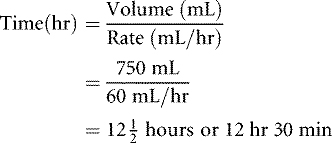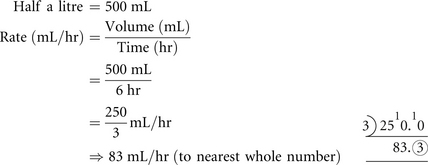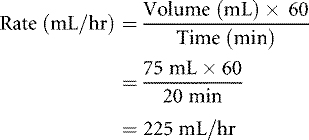4 Intravenous infusion
This chapter deals with the arithmetic of flow rates and drip rates for intravenous (IV) infusion.
Skills covered in this chapter include:
24-hour time will be used in some exercises.
Refer to Inside front cover page for explanations of abbreviations.
Calculating time for an infusion
Exercise 4A
1 An intravenous line has been inserted in a patient. Fluid is being delivered at a rate of 42 mL/hr. How much fluid will the patient receive in a 2 hr b 8 hr c 12 hr?
2 A male patient is receiving Hartmann’s solution at a rate of 125 mL/hr. How much solution will he receive over a 3 hr b 5 hr c 2 hr?
3 A girl is to be given dextrose 5% via an infusion pump. If the pump is set at 60 mL/hr, how much dextrose 5% will she receive in a  b
b  c 12 hr?
c 12 hr?
 b
b  c 12 hr?
c 12 hr?4 A female patient is to receive 500 mL of normal saline. The drip rate is adjusted to deliver 25 mL/hr. How long will the fluid last?
5 A young man is to be given one litre of dextrose 4% in  normal saline. The infusion pump is set at a rate of 80 mL/hr. What time will it take to give the litre of solution?
normal saline. The infusion pump is set at a rate of 80 mL/hr. What time will it take to give the litre of solution?
 normal saline. The infusion pump is set at a rate of 80 mL/hr. What time will it take to give the litre of solution?
normal saline. The infusion pump is set at a rate of 80 mL/hr. What time will it take to give the litre of solution?6 Half a litre of normal saline with 2 g potassium chloride is to be given to a patient IV. How long will this take if the infusion pump is set at 75 mL/hr?
7 A patient is to receive 100 mL of normal saline IV. If the infusion pump is set to deliver 150 mL/hr, how long will the infusion take?
Calculating rates of flow in millilitres per hour (mL/hr) given the time in hours
Exercise 4B
9 Over the next 9 hours, a patient is to receive half a litre of dextrose 4% in  normal saline. At what flow rate should the volumetric infusion pump be set?
normal saline. At what flow rate should the volumetric infusion pump be set?
 normal saline. At what flow rate should the volumetric infusion pump be set?
normal saline. At what flow rate should the volumetric infusion pump be set?10 One litre of Hartmann’s solution is to be given over 12 hours. Calculate the required flow rate for the volumetric infusion pump.
Calculating rates of flow in millilitres per hour (mL/hr) given the time in minutes
Rate (mL/hr) = Rate (mL/min) × 60
In order to do this type of calculation you will need to remember the final formula above.
Note: The volume must be in millilitres (mL)
Exercise 4C
| Medication | Infusion time | |
|---|---|---|
| 1 | 40 mL of fluid containing 600 mg of penicillin | 20 minutes |
| 2 | 120 mL of fluid containing 500 mg of vancomycin | 50 minutes |
| 3 | 100 mL of fluid containing 1 g of flucloxacillin | 30 minutes |
| 4 | 50 mL of fluid containing 0.5 g of potassium chloride | half an hour |
| 5 | 60 mL of fluid containing 75 mg of ranitidine | 35 minutes |
| 6 | 80 mL of fluid containing 80 mg of gentamicin | 45 minutes |
| 7 | 75 mL of fluid containing 75 mg of gentamicin | 40 minutes |
| 8 | 70 mL of fluid containing 1.2 g of penicillin | 25 minutes |
| 9 | 80 mL of fluid containing 750 mg of flucloxacillin | half an hour |
| 10 | 100 mL of fluid containing metronidazole 500 mg | half an hour |




 normal saline.
normal saline. normal saline.
normal saline.







